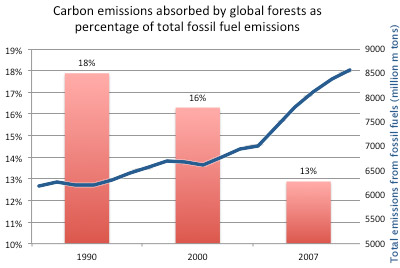Between 1990 and 2007 global forests absorbed nearly one-sixth of all carbon released by fossil fuel emissions, reports a new study published in Science. The results suggest forests play an even bigger role in fighting climate change than previously believed.
The research, conducted by an international team using field data and statistical models across 95 percent of global forests, estimates that forests absorbed a net of 1.1 billion tons of carbon per year from 1990-2007. Forests’ total carbon uptake of 2.4 billion tons per year was offset by deforestation, which released an average of 2.9 billion tons of carbon, but augmented by forest regrowth, which sucked up 1.6 billion tons. Global emissions from fossil fuels averaged 6.9 billion tons per year between 1990-2007, reaching 8.5 billion tons in 2007, according to the Carbon Dioxide Information Analysis Center.
 The proportion of emissions absorbed by forests is declining due to rising fossil fuel emissions. |
The authors say the findings lend support to the Reducing Emissions from Deforestation and Degradation (REDD) program, which aims to create a financial mechanism to compensate developing countries for preserving and sustainably managing their forests. Yet the research also indicates the importance of forests in boreal regions, which store large amounts of carbon, especially in their soils.
“Our estimates suggest that currently the global established forests, which are outside the areas of tropical land-use change, alone can account for the terrestrial C sink,” the authors, led by Yude Pan of the U.S. Forest Service, write. “A large amount of atmospheric carbon dioxide has been sequestrated by the natural system of forested lands (~4.0 billion tons of carbon per year), but the benefit is significantly offset by the carbon losses from tropical deforestation (~2.9 billion tons of carbon per year). This result highlights the potential for Reducing Emissions from Deforestation and Degradation (REDD) to lessen the risk of climate change.”

Forest in Oregon. Photo by Rhett A. Butler (2011).
The authors suggest that a relative abundance of young forests should continue to offset carbon emissions in the future, although they warn that climate change could threaten the effectiveness of forests — especially in boreal and tropical regions — as carbon sinks.
“Because of the large carbon stocks in both boreal forest soils and tropical forest biomass, warming in the boreal zone and deforestation and occasional extreme drought, co-incident with fires in the tropics represent the greatest risks to the continued large carbon sink in the world’s forests,” they conclude.
CITATION: Yude Pan et al. A Large and Persistent Carbon Sink in the World’s Forests, 1990-2007. Science. Volume 333. 15 July 2011.
Related articles
Tropical forests more effective than temperate forests in fighting climate change
(06/20/2011) Preserving forest cover and reforesting cleared areas in the tropics will more effectively reduce temperatures than planting trees across temperate croplands, argues a new paper published in Nature Geoscience.
New global carbon map for 2.5 billion ha of forests

(05/31/2011) Tropical forests across Latin America, Africa, and Southeast Asia stored 247 gigatons of carbon — more than 30 years’ worth of current emissions from fossil fuels use — in the early 2000s, according to a comprehensive assessment of the world’s carbon stocks. The research, published in the journal Proceedings of the National Academy of Sciences by an international team of scientists, used data from 4,079 plot sites around the world and satellite-based measurements to estimate that forests store 193 billion tons of carbon in their vegetation and 54 billion tons in their roots structure. The study has produced a carbon map for 2.5 billion ha (6.2 billion acres) of forests.

(03/25/2010) Global forest loss has diminished since the 1990s but still remains “alarmingly high”, according to a preliminary version of a new assessment from the U.N. Food and Agriculture Organization (FAO). The report, Global Forest Resources Assessment 2010 (FRA 2010), shows that global forest loss slowed to around 13 million hectares per year during the 2000s, down from about 16 million hectares per year in the 1990s. It finds that net deforestation declined from about 8.3 million hectares per year in the 1990s to about 5.2 million hectares per year in the 2000s, a result of large-scale reforestation and afforestation projects, as well as natural forest recovery in some countries and slowing deforestation in the Amazon.
Rainforest conservation more important than developing electric cars
(01/01/2009) For all the fuss that is made about Tesla and the coming generation of electric cars, policy-makers should not overlook the importance of tropical forest conservation.
How satellites are used in conservation

(04/13/2009) In October 2008 scientists with the Royal Botanical Garden at Kew discovered a host of previously unknown species in a remote highland forest in Mozambique. The find was no accident: three years earlier, conservationist Julian Bayliss identified the site—Mount Mabu—using Google Earth, a tool that’s rapidly becoming a critical part of conservation efforts around the world. As the discovery in Mozambique suggests, remote sensing is being used for a bewildering array of applications, from monitoring sea ice to detecting deforestation to tracking wildlife. The number of uses grows as the technology matures and becomes more widely available. Google Earth may represent a critical point, bringing the power of remote sensing to the masses and allowing anyone with an Internet connection to attach data to a geographic representation of Earth.







